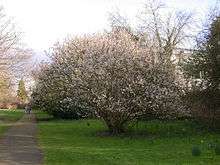Prunus pseudocerasus
Prunus pseudocerasus or Prunus pseudo-cerasus, the Chinese sour cherry or just Chinese cherry, is a species of cherry native to China and is used worldwide as an ornamental for its early spring cherry blossoms.
| Prunus pseudocerasus | |
|---|---|
 | |
| Chinese sour cherry in bloom | |
| Scientific classification | |
| Kingdom: | Plantae |
| Clade: | Tracheophytes |
| Clade: | Angiosperms |
| Clade: | Eudicots |
| Clade: | Rosids |
| Order: | Rosales |
| Family: | Rosaceae |
| Genus: | Prunus |
| Subgenus: | Prunus subg. Cerasus |
| Section: | P. sect. Cerasus |
| Species: | P. pseudocerasus |
| Binomial name | |
| Prunus pseudocerasus | |
| Synonyms | |
| |
Description
_flower_1.jpg)
A small bushy tree growing to at most 8 m, it generally has reddish buds, pale pink 2 cm flowers and typical red (if a bit pale) 1.5 cm cherries.[1] It can be distinguished from its congeners by certain traits; its 7-16 cm leaves are broadly obovate, with an acuminate tip, flat and serrated, its inflorescences are corymbose or subumbellate, with at least three and as many as seven flowers, and its branches and peduncles are pubescent.[2][1]
Uses
In China it has been cultivated for its edible (if tart) fruit for around 2000 years.[1] In Japan it is favored as an ornamental tree for its tendency to bloom, flowers before leaves, earlier than the Japanese cherry Prunus serrulata.[3] A tetraploid with 2n=32 chromosomes, it is used as rootstock for other flowering cherries. It is the parent of a number of hybrid cultivars.[4][3] It is resistant to the fungal disease cherry leaf spot.[5][6]P. pseudocerasus contain carotene, vitamin C, proteins, saccharides, iron, and phosphorus. The P. pseudocerasus is near extinction due to anthropogenic activities.[7]
References
- Jules, Janick; Paull, Robert E (2006). The Encyclopedia of Fruit & Nuts. Cambridge, MA: CABI North American Office. p. 732. ISBN 9780851996387.
- Encyclopædia of Plants; comprising the specific character, description, and every other desirable particular respecting all the plants indigenous to Britain. Ed. by Mrs. Loudon, assisted by G. Don and D. Wooster. London, 1872.
- Kuitert, Wybe (1999). Japanese Flowering Cherries. Portland, Oregon: Timber Press. ISBN 9780881924688.
- Feng, Ying; Liu, Tao; Wang, Xiao-Yu; Li, Bin-Bin; Liang, Cheng-Lin; Cai, Yu-Liang (March 2018). "Characterization of the complete chloroplast genome of the Chinese cherry Prunus pseudocerasus (Rosaceae)". Conservation Genetics Resources. 10 (1): 85–88. doi:10.1007/s12686-017-0770-9.
- Verma, LR; Sharma, RC (1999). Diseases of Horticultural Crops : Fruits. p. 240. ISBN 9788173870958.
- https://pfaf.org/user/Plant.aspx?LatinName=Prunus+pseudocerasus
- Ying , Feng, and Cai YL et al. Characterization of the Complete Chloroplast Genome of the Chinese Cherry Prunus Pseudocerasus (Rosaceae). SPRINGER, VAN GODEWIJCKSTRAAT 30, 3311 GZ DORDRECHT, NETHERLANDS.
| Wikimedia Commons has media related to Prunus pseudocerasus. |